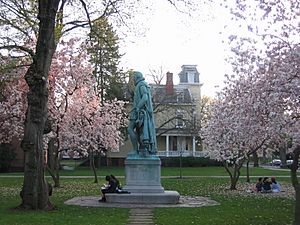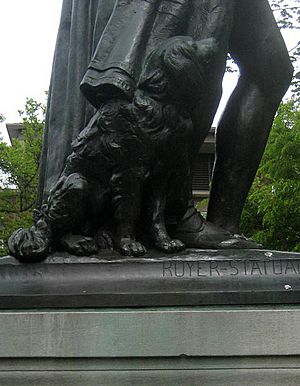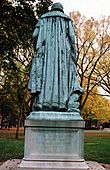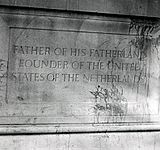Statue of William the Silent facts for kids
Quick facts for kids William the Silent |
|
|---|---|

Statue of William the Silent on Rutgers University's Voorhees Mall
|
|
| Artist | Toon Dupuis (1877–1937) after Lodewyk Royer (1793–1868); Fonderie Nationale des Bronzes |
| Year | 1920 |
| Type | Bronze sculpture, granite base |
| Location | New Brunswick, New Jersey, United States |
| 40°30.087′N 74°26.877′W / 40.501450°N 74.447950°W | |
| Owner | Rutgers, The State University of New Jersey |
| Accession | Dedicated June 9, 1928 |
A bronze statue of William the Silent stands at Rutgers University in New Brunswick, New Jersey. It was put in place in 1928 on the Voorhees Mall. This area is a part of the College Avenue Campus. The statue is near several school buildings. These include the Graduate School of Education and Van Dyke Hall.
The statue was a gift to Rutgers from Dr. Fenton B. Turck. He wanted to celebrate the university's Dutch history. Dr. Turck worked with Leonor F. Loree, a Rutgers graduate. They arranged for the statue to be given anonymously through the Holland Society of New York. The statue shows William I, Prince of Orange (1533–1584). He was an important leader in the Dutch fight for freedom. This war was against Habsburg Spain. It led to the Netherlands becoming independent in 1648.
The statue is still a part of student life. The Voorhees Mall is used for many events. These include graduation parties, pep rallies, and festivals. Sometimes, the statue is painted by students from Princeton University. This is part of a long-standing rivalry between the two schools. The statue was cleaned and fixed in 2006. Alumni donations paid for this work.
Contents
History of the Statue
How the Statue Came to Rutgers
After World War I, a doctor named Fenton Benedict Turck (1857–1932) traveled in Europe. He bought a bronze statue of William I. William was a Prince of Orange and a hero in the Netherlands. He was also known as "William of Orange." William led the Dutch revolt against Spain. This war helped the Netherlands become a free country. Because of this, William is called the "Father of the Fatherland" of the Netherlands.
The statue is a copy of an older one made in 1848. That one was created by Dutch sculptor Lodewyk Royer. It stands in a city square in the Hague. The original mold for Royer's statue was kept in Brussels. After the war, the Dutch government allowed one copy to be made. Sculptor Toon Dupuis made this copy. It was cast at a foundry in Brussels. After this, the mold was destroyed.
Dr. Turck was a doctor and researcher. He was a direct descendant of a Dutch doctor who treated William the Silent. This was after William was badly hurt in an attack in 1581. When Dr. Turck returned to the United States, he felt the statue was very expensive. He decided to hide it from his wife. He stored it in the basement of his lab in New York City. The statue stayed there for eight years.
Finding a Home for the Statue
Dr. Turck joined the Holland Society of New York in 1917. This group wanted to put a monument in New York City. They wanted to celebrate the city's Dutch history. In 1892, they agreed that William the Silent should be the subject. They thought about putting it in Central Park. World War I delayed their plans. In the 1920s, the Holland Society suggested many places for Turck's statue. These included New York City and Albany, New York.
In 1924, the Holland Society tried again to place the statue in Central Park. The city's Parks Commissioner first agreed. But the city's Art Commission did not. An official from the Art Commission suggested Rutgers College instead. He said it would be a "nice new and very visible gift." It would connect the university to its Dutch past.
Dr. Turck talked with his friend, Leonor Fresnel Loree. Loree was a railroad executive and a Rutgers graduate. He told Turck about Rutgers University's Dutch roots. He convinced Turck to give the statue to the university. Loree was on the college's board of trustees at the time. Rutgers was founded in 1766 as Queen's College. It was started by Dutch Reformed church leaders. Many students of Dutch background went there.
Dr. Turck wanted to give the statue without anyone knowing it was from him. With Loree's help, the Holland Society gave the statue to Rutgers. A Rutgers trustee said it was "particularly fitting" for the statue to be at Rutgers. The statue was delivered and put in place at the western end of the Voorhees Mall. It was officially dedicated on June 9, 1928.
Student Life and the Statue
Rutgers students have nicknames for the statue. They call it "Willie the Silent" and "Still Bill." There's a fun student story that the statue will whistle if a virgin walks by. But a professor said, "But over the last 200 years, he hasn't yet whistled."
The statue is still a big part of student life. The Voorhees Mall is used for many school and community events. These include graduation ceremonies and pep rallies for sports teams. Dutch-American festivals are also held there. In the 1970s, there were protests and strike rallies. On October 11, 1976, United States Senator Ted Kennedy held a campaign rally at Rutgers. He spoke to about 1,000 students in front of the statue.
Sometimes, the statue is a target of vandalism. This is part of a long-standing rivalry between Rutgers and Princeton University. This rivalry started with the first college football game in 1869. It led to pranks and thefts. Princeton students often paint the William the Silent statue orange. This usually happens before sports games. In 1947, Princeton students painted the statue before a football game. In 2006, Rutgers police chased some vandals from the site. They were thought to be Princeton students.
The statue was fixed in 2006. Money for this came from Rutgers alumni from the Class of 1956. About $150,000 was used to fix the statue and four historic gates on campus. The statue was cleaned to remove paint and tape marks. Work was also done to restore the bronze and its granite base.
About the Statue
The statue of William the Silent was put on the Voorhees Mall in 1928. This area is part of the College Avenue Campus in New Brunswick. The statue is next to Seminary Place. This street separates the Rutgers campus from the New Brunswick Theological Seminary. It is near several school buildings.
The bronze statue is about 15 feet tall. It stands on a square stone base that is about 6 feet tall. The statue weighs 2,000 pounds. It shows William the Silent standing up. He has his right hand raised to his chest. He points with his finger. He holds an open scroll in his left hand. A small dog sits at his right foot. William the Silent wears clothes from the 16th century. He has a mustache and a beard. He wears a ruffled collar, a long coat, a buttoned vest, and bloomers.
The stone base of the statue has words carved into each of its four sides:
- Front (facing east): WILLIAM THE SILENT / COUNT OF NASSAU / PRINCE OF ORANGE / MDXXXIII MDLXXXIV
- Back (facing west): THE HOLLAND SOCIETY / OF NEW YORK / TO RUTGERS UNIVERSITY / MCMXXVIII
- Right (facing south): FATHER OF HIS FATHERLAND / FOUNDER OF THE UNITED / STATES OF THE NETHERLANDS
- Left (facing north): AS LONG AS HE LIVED / HE WAS THE GUIDING STAR / OF A WHOLE BRAVE NATION / AND WHEN HE DIED THE / LITTLE CHILDREN CRIED
The sculpture also has two marks near its base. These show who made it: "ROYER – STATUAIRE" and "FONDERIE NATLE DES BRONZES".
Gallery
- The statue
- Inscriptions
See also
 In Spanish: Estatua de Guillermo el silencioso para niños
In Spanish: Estatua de Guillermo el silencioso para niños











